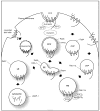Chemokine receptor internalization and intracellular trafficking
- PMID: 15998596
- PMCID: PMC2668263
- DOI: 10.1016/j.cytogfr.2005.05.008
Chemokine receptor internalization and intracellular trafficking
Abstract
The internalization and intracellular trafficking of chemokine receptors have important implications for the cellular responses elicited by chemokine receptors. The major pathway by which chemokine receptors internalize is the clathrin-mediated pathway, but some receptors may utilize lipid rafts/caveolae-dependent internalization routes. This review discusses the current knowledge and controversies regarding these two different routes of endocytosis. The functional consequences of internalization and the regulation of chemokine receptor recycling will also be addressed. Modifications of chemokine receptors, such as palmitoylation, ubiquitination, glycosylation, and sulfation, may also impact trafficking, chemotaxis and signaling. Finally, this review will cover the internalization and trafficking of viral and decoy chemokine receptors.
Figures

References
-
- Yang W, Wang D, Richmond A. Role of clathrin-mediated endocytosis in CXCR2 sequestration, resensitization, and signal transduction. J Biol Chem. 1999;274:11328–33. - PubMed
-
- Vila-Coro AJ, Mellado M, Martin de Ana A, Martinez AC, Rodriguez-Frade JM. Characterization of RANTES- and aminooxypentane-RANTES-triggered desensitization signals reveals differences in recruitment of the G protein-coupled receptor complex. J Immunol. 1999;163:3037–44. - PubMed
Publication types
MeSH terms
Substances
Grants and funding
LinkOut - more resources
Full Text Sources
Other Literature Sources

